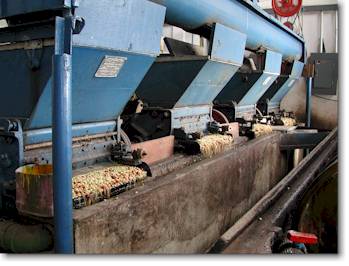Flavor Characteristics
Due to Coffee Processing
 Dry-Process:
The dry-process (also known as the natural method) produces
coffee that is heavy in body, sweet, smooth, and complex.
The dry-process is often used in countries where rainfall
is scarce and long periods of sunshine are available to dry
the coffee properly. Most coffees from Indonesia, Ethiopia,
Brazil, and Yemen are dry-processed.
Dry-Process:
The dry-process (also known as the natural method) produces
coffee that is heavy in body, sweet, smooth, and complex.
The dry-process is often used in countries where rainfall
is scarce and long periods of sunshine are available to dry
the coffee properly. Most coffees from Indonesia, Ethiopia,
Brazil, and Yemen are dry-processed.
Wet-Process:
Wet-processing coffees is a relatively new method of removing
the four layers surrounding the coffee bean. This process
results in a coffee that is cleaner, brighter, and fruitier.
Most countries with coffee valued for its perceived acidity,
will process their coffee using the wet-process.
Pulped Natural:
The pulped natural method consists of pulping a coffee, but
emitting the fermentation stage to remove the silverskin.
This results in a beverage that has characteristics of both
a dry- and wet-processed coffee. It is often sweeter
than wet-processed coffees, has some of the body of a dry-processed
coffee, but also retains some of the acidity of a wet-processed
coffee. This type of processing can only occur in countries
where the humidity is low and the coffee covered in the sweet
mucilage can be dried rapidly without fermenting. Brazil
has made this method famous and produces some of the best
pulped natural coffees in the world. All twenty winners of
the Gourmet Cup competition in Brazil in 2000 processed their
coffees using the pulped natural method.
Re-passed:
There is another type of coffee that has emerged on the market
called re-passed or raisins. These coffees are floaters
and are usually discarded with the rest of the floaters.
However, they have a flavor profile that some of the world's
best experts find to be much sweeter than traditional pulped
coffees. The cherries float because they have dried
too long on the tree before being collected. This, however,
allows the bean to interact with the mucilage for a longer
amount of time before the start of fermentation. The
beans are removed from the rest of the floaters using a barrel
system developed by Eduardo Sampio in Brazil. The coffees
are then re-passed and pulped. They can then be washed
or used as pulped naturals. The availability of the
curiously sweet re-passed coffees is very limited since it
is mainly experimental at this time. Ask your Brazilian
supplier if they separate out this type of coffee and what
flavor characteristics this coffee possesses. It may
be another option for espresso blending and is likely to become
the fourth category of coffee processing.
Comparison:
The vast majority of coffee producers will claim the virtue
of their processing method. In Guatemala, for example, dry
processing is a bad word and rightly so. Due to their high
humidity a dry processed coffee will almost definitely be
fermented, which is why only their lowest grade coffees are
dried without pulping. However, in Brazil, dry processing
results in a sweet, complex, and heavy-bodied coffee that
is almost essential in any good espresso blend. The only conclusion
that one can make is that every region has its own proper
processing technique and that the processing technique should
help attain the flavor profile that is desired by the producer
and consumer.
Other Flavor
Contributors: The processing method used on a coffee is
usually the single largest contributor to the flavor profile
of a coffee. The differences between a washed and dry-processed
Brazilian coffee from Sul de Minas will generally be more distinct
than the differences between two wet-processed coffees from
two different regions. However, the microclimate and soil
are the next major contributors to the flavor profile of a
coffee and assuming processing is done correctly, they become
the most important contributors to flavor profile.
Related
Articles
Coffee
Cupping
Coffee
Cupping Form
Tongue
Maps for Coffee
Coffee Chemistry- Aroma
Coffee
Chemistry- Bitterness
Coffee
Chemistry- Acidity


